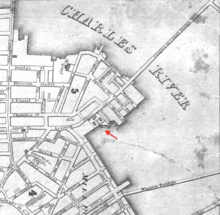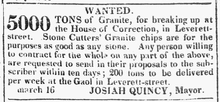Leverett Street Jail
The Leverett Street Jail (1822–1851) in Boston, Massachusetts served as the city and county prison for some three decades in the mid-19th century. Inmates included John White Webster.[1] Notorious for its overcrowding, the facility closed in 1851, when inmates were installed in the nearby, newly built Charles Street Jail, also in the West End.[2]
History


Begun around 1819, the "new gaol in Leverett-street" opened in 1822.[3] Prior to that time, many had recognized the previous town jail (since the 1630s located off Court Street) as inadequate.[4][5]
In 1823, "on inspecting the common jails of the city, in Leverett Street, it was found that, of the two stone prisons there situated, one was amply sufficient for all the usual exigencies of the courts of justice. It was determined, therefore, to convert the other into a house of correction, and employ the inmates in the adjoining jail-yard in hammering stone and like materials."[6] Thus "there were two separate prisons within the same enclosure."[1]
Architecture
Architecturally, "the Leverett Street jail was considered very secure, walls and floors being composed of large blocks of hewn stone clamped together with iron, while between the courses loose cannon-balls were laid in cavities hollowed out for the purpose."[1]
Inmates
Don Pedro Gibert and his pirate associates on trial in Boston in 1834 were held in the Leverett Street jail.[7][8] In 1835 abolitionist William Lloyd Garrison was held in the jail temporarily for his own protection when a mob turned against him.[9]
Others held in the prison included, for instance, people in custody after police raids on Ann Street. One night in 1851, "165 persons of all ages, sexes, nations and colors ... were marched off in pairs to the Leverett Street Jail ... for the various crimes of piping, fiddling, dancing, drinking, and all their attendant vices."[10]
Executions took place at the jail. In 1831, "Joseph Gadett and Thomas Colinett [were hanged] ... for piracy," and in 1834 Henry Joseph also.[10] In 1850, Dr. Webster of the highly publicized George Parkman murder case was executed.
Conditions in the prison
The conditions in the jail were widely criticized. Prisoners lived crowded together, regardless of the mildness (e.g. minor debt) or severity of their crime. "The new, costly, and elegant prison ... is so constructed as not to admit of a proper separation of its inmates."[11] By 1831, "the true character of this place is beginning to be understood:"
The crowded night rooms; the 1,000 debtors annually, and the 1,000 criminals and vagrants; the men and the women; the old men and black boys; the idiots, the lunatics and the drunkards; all confined in two buildings at night, and on the Sabbath, in which there can be no separation, and no effectual supervision or restraint, to prevent gambling and falsehood, profane swearing and lascivious conversation, wrath, strife, backbiting and revenge.[12]
In 1833 the city built a new House of Correction in South Boston, designed on the Auburn system (an improvement at the time). After 1833 "as the city and county lock-up the Leverett Street Jail held inmates who were awaiting trial and also those who had been sentenced to the [South Boston] House of Correction and were waiting for transport there. "[2] "De Beaumont and de Tocqueville declared the House of Correction in South Boston to be a model for similar establishments, and the county jail in Leverett Street just the opposite."[13] In other words, conditions improved for inmates in the new South Boston prison, but remained objectionable for inmates remaining at Leverett Street.
By around 1843,
it will cause sorrow and pain to the citizens of Boston that ... we still have a jail, on Leverett Street, which has been presented as a nuisance by the grand jury; which has had proceedings instituted against it, year after year, by the city government ... and yet there is not final action for its removal or change.[14] In 1851 "it was finally replaced by a new jail on Charles Street known as the Charles Street Jail."[2][15] The old jail building on Leverett Street stood until at least 1856.[16]
References
- Samuel Adams Drake (1876). Old landmarks and historic personages of Boston.
- City of Boston Archives and Records Management Division. "Guide to the Charles Street Jail records". Archived from the original on June 10, 2010. Retrieved April 10, 2010.
- American Federalist Columbian Centinel, January 29, 1823,
Aldermen [Ephraim] Eliot, [Bryant Parrott] Tilden, and [Joseph] Jenkins were appointed a committee to view the new Gaol in Leverett-street
- Theophilus (June 18, 1819), "Suffolk County Gaol", New-England Galaxy
- Caleb Snow (1828), History of Boston,
In 1823 the old gaol was taken down, and its materials were partly used in constructing the Gun house and Ward Room on Thacher Street
- Josiah Quincy (1852). Municipal history of the town and city of Boston. Boston: C.C. Little and J. Brown.
- Mark Antony De Wolfe Howe (1912), Boston: the place and the people, Macmillan
- For more on the trial, see: Trial of the Twelve Spanish Pirates of the Schooner Panda, A Guinea Slaver... For Robbery and Piracy, Committed on Boards the Brig Mexican, 20th Sept. 1832, Boston: Lemuel Gulliver, 1834
- Albert William Mann (1917), Walks & talks about historic Boston
- Edward Hartwell Savage (1865), Chronological history of the Boston watch and police, Boston
- Christian Examiner, 3, May–June 1826
- 6th Annual report of the Board of Managers of the Prison Discipline Society, Boston, 1831
- Orlando Faulkland Lewis (1922), The development of American prisons and prison customs, 1776-1845, Prison Association of New York, p. 282
- Prison Discipline Society (1843), 18th Report, Boston
- Roger G. Reed (2007). Building Victorian Boston: the architecture of Gridley J.F. Bryant. Univ of Massachusetts Press.
- Boston Directory, 1856
Further reading
| Wikimedia Commons has media related to Leverett Street Jail. |
- City Expenditures and Resources: Tenth Annual Report. American Federalist Columbian Centinel, September 11, 1822.
- Boston Board of Aldermen. Report of the committee on the Jail and Houses of industry, correction, and reformation, 1831.
- 6th Annual report of the Board of Managers of the Prison Discipline Society. Boston: 1831.
- Boston Board of Aldermen. Report of the committee on the Jail and Houses of industry, correction, and reformation, 1834.
- 10th Annual report of the Board of Managers of the Prison Discipline Society. Boston: 1835.
- Boston City Council. Leverett Street Jail. 1841.
External links
- "Leverett Street Jail, Padlock and Key", Home Front: Boston and the Civil War, Exhibitions, Boston Public Library, 2011